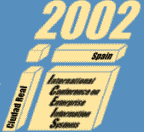|
| Tutorial
1 |
| Network Security Concepts and Java |
Network security is becoming increasingly important in an economy where services are delivered over the web. Several layers need to deliver a well
co-ordinated end to end security.
This session will quickly cover the concepts of network security and deep dive into the newer features of Java 2 Platform, Standard Edition (J2SE) security. Thin client security offered by
JavaCard, and Java 2 Platform, Micro Edition (J2ME) will be covered as well. Java 2 Platform, Enterprise Edition (J2EE) security and security as offered by deployment platforms like Solaris and Linux will be introduced. Finally, XML security, which
is becoming a standard for web-based security will be explored.
Attend this session to understand the various aspects of security that are essential to implement layered security for web services.
Brief Bio of Dr. Raghavan "Rags" Sriniva
Dr. Raghavan "Rags" Srinivas is a Java Technology Evangelist at
Sun Microsystems. He specializes in Java and distributed
systems. He is a proponent of Java tehnology and teaches
undergraduate and graduate classes in the evening. He has
spoken on a variety of technical topics at conferences
around the world.
Rags brings with him about 15 years of software
development experience. He worked for Digital Equipment
Corporation before joining Sun. He has worked on several
technology areas, including internals of VMS, Unix and NT.
Rags holds a Masters degree in Computer Science from
the Center of Advanced Computer Studies at the University
of Southwestern Louisiana.
He enjoys running, hiking and eating spicy food.
| Tutorial
2 |
| Maintenance of Information Systems |
Drawing upon field experience,
observation, and research, this full-day tutorial focuses on the aspects and practices of management important in managing the
maintenance of information systems (IS). The following topics are planned for coverage (the tutorial will be conducted in English):
- Recognizing what makes IS maintenance management different
- Managing the product of IS maintenance
- Overviewing maintenance processes to be managed and the maintenance cycle
- Managing the cost of maintenance
- Managing the quality of maintenance
- Managing the value of maintenance
- Organizing maintenance
- Managing decision making
- Supervising maintainers
- Managing IS evolution
Because the tutorial proceeds with a mix of discussion, lecture, and workshop activities, the sequence, amount of emphasis,
and depth and level of coverage of the topics will be modified as the day progresses. The adjustments will be shifts to
reflect the expressed interest of the persons attending. This tutorial is intended for persons with supervisory or management
functions with respect to IS maintenance, and for persons who expect to have such functions. The main objective of this tutorial
is to provide those attending with a basis for becoming more successful in their supervisory and management functions with
respect to information systems maintenance.
Brief Bio of Dr. Ned Chapin
Dr. Ned Chapin has served as an Information Systems Consultant and as a Professor
of Information Systems. His more than three decades of experience in the information
systems field have covered a breadth of industries (financial, manufacturing,
insurance, extractive, distribution, services, and governmental organizations) in a width
of areas (commercial, industrial, managerial, process control, operations, engineering,
and research applications and systems software), both in the USA and internationally.
He has worked with computers from large to small, in a diversity of languages,
software environments, and operating systems. He has been active in and contributed
to systems, techniques, methods, and management in all phases of the life cycle of
systems, including feasibility, systems proposals and evaluations, analysis, design,
programing, coding, debugging, testing, documentation, conversion, operation,
maintenance, and post–installation audit. He has served as an expert witness in
litigation in both state and Federal courts, and contributed to the computer field in the
areas of software engineering, database, computer programing, software metrics,
software maintenance, and management technology.
Dr. Chapin is the author of more than two hundred papers and articles, and half
a dozen books published on aspects of the computer field. He has served as the Editor
of the professional Journal of Software Maintenance, as the conference chair of
professional meetings, as a member of the program committee of both national and
international conferences, as a national lecturer and national seminar leader, and
served on the advisory and editorial boards of professional journals and trade magazines.
He has been active in the professional societies at local, national, and international levels,
and been a member of more than a dozen of them including the IEEE
Computer Society, the Association for Computing Machinery (ACM), the British
Computer Society (BCS), the Association of Information Technology Professionals
(AITP, formerly DPMA), the Association for Computers and the Humanities (ACH), the
Information Systems Audit and Cont ol Association (ISA CA), and the Software Maintenance
Association (SMA) for which he was a founder and the first President. He is
also a member of the New York Academy of Sciences and of Sigma Xi—the Scientific
Research Society of America.
Dr. Ned Chapin earned an MBA from the Graduate School of Business of the
University of Chicago, and a Ph.D. from Illinois Institute of Technology. He also has
been awarded the CCP (Certificate in Computer Programing), CDP (Certified Data
Processor), CDE (Certified Data Educator), CSP-with honors (Certified Systems
Professional), CISA (Certified Information Systems Auditor), and PE (Registered
Professional Engineer). Dr. Chapin works from Menlo Park in California USA.
| Tutorial
3 |
| Developing Enterprise Applications using Java |
The Web has evolved from a network-based hypermedia distributed
information system offering static information to a marketplace for
selling and buying goods and services. Sophisticated applications are
required to enable this marketplace.
The Java 2 Enterprise Edition (J2EE) is a standard platform for the
development and deployment of enterprise applications. It reduces the cost
and complexity of developing multitier enterprise applications as it
provides a multitier distributed application model. In other words, it is
inherently distributed and therefore the various parts of an application
can run on different devices.
The architecture of J2EE, which is component-based, makes developing
enterprise applications easy because business logic is organized into
reusable components and the underlying service is provided by J2EE in the
form of a container for every component type. Think of a container as the
interface between the component and the low-level functionality that
supports the component. Therefore, before an application client component
can be executed, it must be configured as a J2EE service and deployed into
its container.
This tutorial explores the various services offered by J2EE and offers
practical experience on how to use them. The tutorial will help
participants understand the J2EE and give them a flavor of the effort
involved in creating reliable secure enterprise applications.
The list of major topics to be covered in this tutorial include:
- An indepth look at J2EE
- Indepth coverage of the major services offered by J2EE
- Developing enterprise applications with Servlets, JSP, and XML
- Developing and using Enterprise JavaBeans (EJBs) from JSPs
- Developing reusable enterprise components
- Describing J2EE services in a Web Application Descriptor (web.xml)
- Referencing, accessing, and using J2EE services from servlets and JSPs
- Using JDBC, JNDI, and RMI
Brief Bio of Dr. Qusay H. Mahmoud
Qusay H. Mahmoud is a faculty member in the School of Computing Science at
Simon Fraser University, Canada. Qusay has published dozens of articles,
and he is the author of two books Distributed Programming with Java
(Manning Publications, USA) and Wireless Java (O'Reilly and Associates,
USA).
| Tutorial
4 |
| Business process modeling as a method of requirements engineering |
Today, at least half of the industrial software development is connected to business application development.
During the past ten years, requirements on functionality of business applications have been slowly changing.
This shift consists of moving from traditional command based applications to the applications of workflow and groupware type.
Such applications are aimed at "controlling" business processes. Designing an appropriate "control" system presumes that
the nature of the process that we want to control is fully understood.
The tutorial will cover the following topics:
1. Paradigm shift in business application development.
2. What is business process?
3. General requirements on the software that supports business processes.
4. How to analyze, visualize and specify business processes.
5. How to use a business process model as a specification for the system aimed at supporting the process.
Scope: Requirements engineering
Learning objectives: To understand the problems and solutions of building a new generation of business applications.
Who should attend:
- Software engineers interested in building business (enterprise) applications.
- Business analysts interested in requirements specification for business applications.
- Researchers interested in workflow, business process modeling, etc.
Brief Bio of Dr. Ilia Bider
Ilia Bider is a cofounder and Director R&D of IbisSoft (Stockholm, Sweden). He has combined experience
of over twenty years of research, and practical work on all level (research, business and system analysis, system design,
coding, sells, and marketing) in 5 countries (Norway, Russia, Sweden, UK, US). He has published more than 20 research papers
as well as a number of articles for practitioners.
The material for the tutorial is based on Ilia's theoretical and practical work in the field of business process analysis and
application development. In particularly, some materials have originated from the discussions at international workshops devoted
to business process modeling that Ilia co-organized in 1998, and 2000: Workshop on Object-Oriented Business Process Modeling
at ECOOP'98, and Workshop on Practical Business Process Modeling at CaiSE*2000. Another important source is Ilia's practical
work on business process analysis, and building application systems that support business processes. One of the applications
built on the technology presented in the tutorial won the "Object Applications of the Year Awards 1997" at Object World Show
in London.
Page Updated on
19-10-2006
Copyright © Escola Superior de Tecnologia
de Setúbal, Instituto Politécnico de Setúbal |





